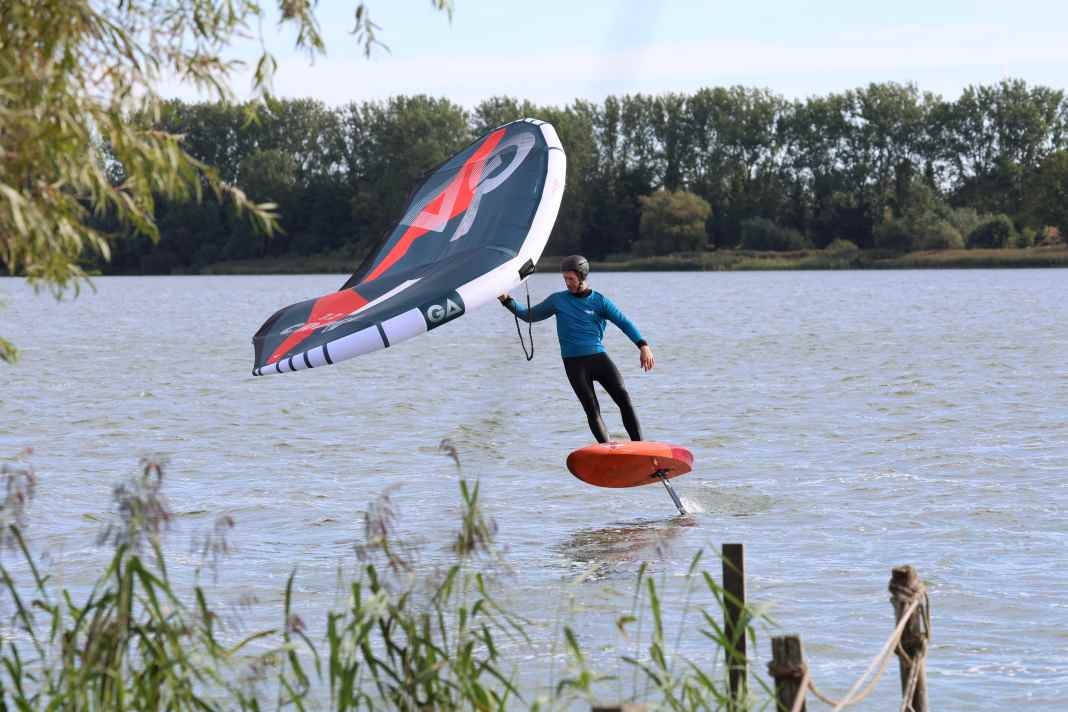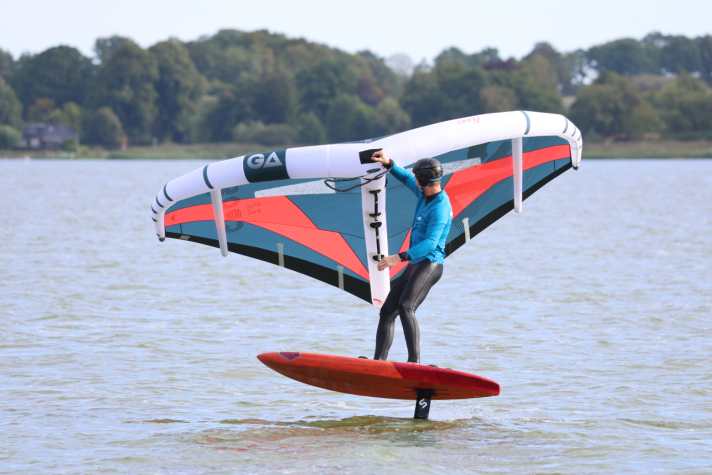





Complementary to the Cross model (HERE is a test) GA also has the Cross LW in its programme. The abbreviation LW stands for Light wind.
On land
The Cross model already impressed us in the test as a particularly powerful representative, and the Cross LW aims to go one better. The light wind version is available in the sizes 6.7/7.2/7.7 and 8.2 square metres; we were able to test ride the size 7.2 extensively. Compared to last year's model, the wingtips have been made shorter to prevent the tips from dragging when pumping. In addition, the Cross LW now offers a longer handle that allows the wing to be ridden one-handed. If you prioritise booms, you can also swap the individual handles for a boom; the 110 length fits all sizes of the Cross LW. To ensure control in stronger gusts, the Wing has two additional struts that are ventilated via a one-pump system together with the front tube. Keyword "ventilation": GA also relies on the widely used SUP valves without exception.
In the front area, the designers have given the wing a lot of profile tension, but in the rear area it is cut quite loosely, which should make it easy to charge. Small mini battens have been incorporated here to prevent the trailing edge from flapping. The front handle attracts some criticism, as it could have been made a little stiffer and thicker, but the rest of the equipment makes a very high-quality and well thought-out impression. The GA Cross LW comes with a bag and leash, the boom is offered as an optional accessory.

On the water
Even with only five or six knots of wind, the Cross LW already develops enough lift to float with a steady pull. As always, how early you take off depends on the board, foil, weight and pumping technique. With a 106-litre mid-length board and 1800 foil, our 90-kilo test rider was able to take off well at just under eight knots. We would rate the pure light wind power at the good level of the Duotone Ventis (HERE is a test) categorise. One positive aspect of the Cross LW is how easy it is to extract the wing's power: At the lowest wind limit, the recommended inflation pressure can even be undercut by 0.5 psi, because the wing then builds up pull even more efficiently.
The range of use of the GA Cross LW fortunately extends far beyond the absolute light wind range. Even when powered up, the wing impresses with an extremely stable flight attitude and turns out to be a powerful freeride motor that demands a determined pull. However, corrections to the flying position or annoying load changes are not an issue at all with the Cross LW in the wind range up to 15 knots. For downwinders in light winds, the wing can also be pulled along nicely, only the front handle could have been a little stiffer.

For a wing of this size, the Cross LW leaves nothing to be desired when it comes to manoeuvres. Due to their dimensions, these models are naturally not made for tricks and twirling around, but a relaxed duck jibe or a Foil 360 is absolutely no problem with the Cross LW. The wing can also be flipped tip-to-tip when tacking.
GA Cross LW - the conclusion
The GA Cross LW convinces in its core competence "Power" and enables efficient and early take-off at the lowest wind limit. Fortunately, even stronger gusts do not throw the wing off course, resulting in a wide range of use. Ideally, the Wing should be combined with slim mid-length boards; we would then locate the wind range of the tested 7.2 between six and 15 knots. Sizes 6.7 or 7.2 should be absolutely sufficient for wingfoilers under 80 kilos. Only foilers over the 95-kilo mark should choose even larger sizes.
Power, wind range
Front handle slightly soft
-
GA Cross LW - technical data
- Test model: GA Cross LW 7.2 (2025)
- Wingspan: 370 cm
- Depth: 260 cm
- Weight (own measurement, without leash): 3.76 kg
- Weight: 522 g/m2
- Available sizes: 6.7/7.2/7.7/8.2 square metres
- Scope of delivery: Wing, rucksack, leash
- Price (test model): 1499 Euro
- Contact: To the website
- Special features: Alternatively mobile with boom; 2 colour variants

